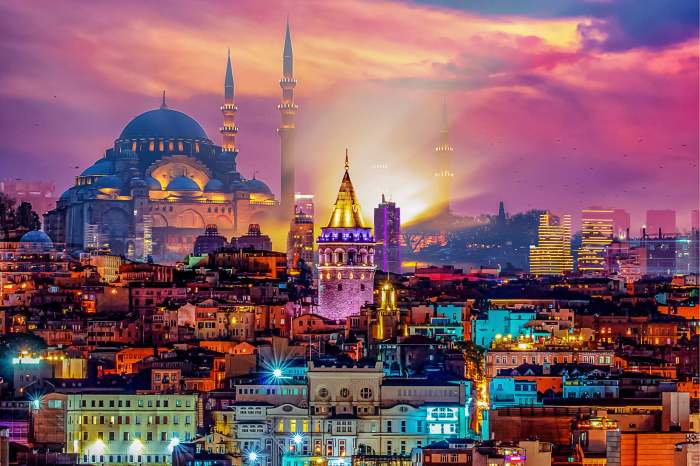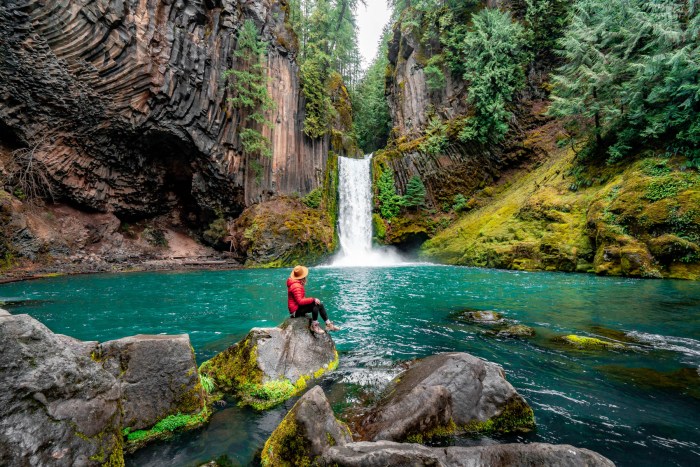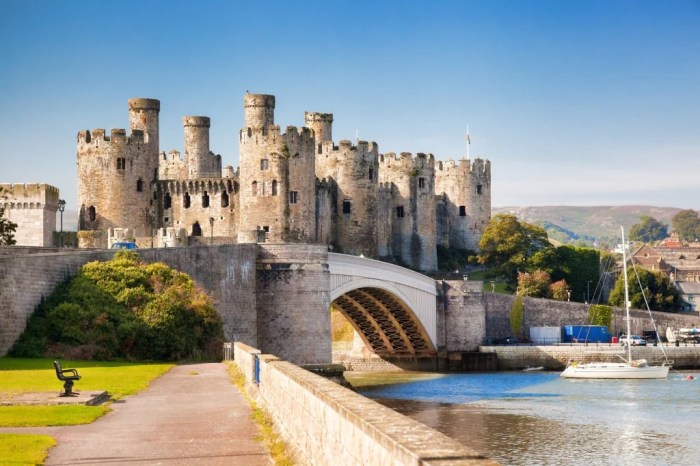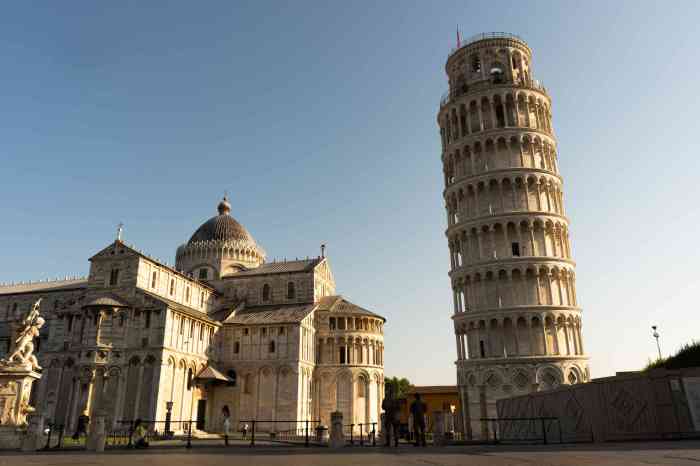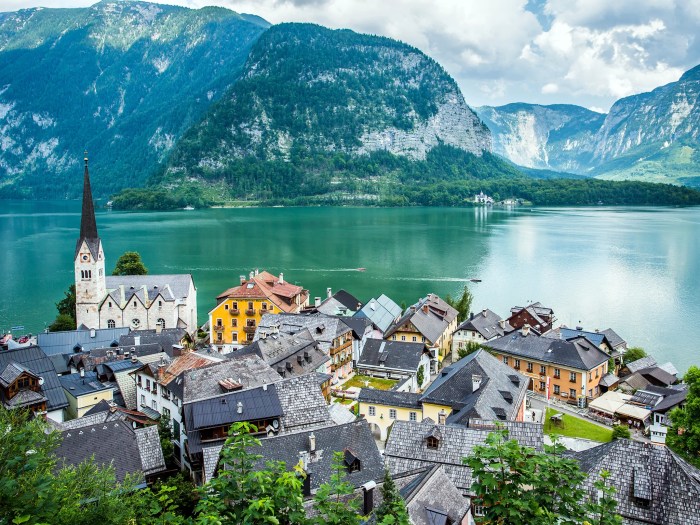Top 10 Places To Visit In Turkey
Top 10 Places To Visit In Turkey: From the bustling streets of Istanbul to the surreal landscapes of Cappadocia, Turkey offers a captivating blend of history, culture, and natural beauty. Whether you’re a history buff, an adventure seeker, or a beach lover, Turkey has something for everyone.
Get ready to explore ancient ruins, wander through vibrant bazaars, and soak in the stunning scenery of this incredible country.
Turkey’s diverse landscape and rich history have shaped its unique identity. From the ancient cities of Ephesus and Hierapolis to the stunning natural wonders of Pamukkale and the Black Sea Region, each destination offers a glimpse into the country’s past and present.
This list will guide you through the top 10 must-see places in Turkey, offering a taste of the country’s rich tapestry of culture, history, and natural beauty.
Istanbul: The Heart of Turkey
Istanbul, a city that straddles the continents of Europe and Asia, is a vibrant metropolis brimming with history, culture, and breathtaking beauty. A city of contrasts, Istanbul offers a glimpse into the past while embracing the present. Its strategic location, bridging the East and West, has made it a cultural melting pot, a crossroads of civilizations, and a hub of trade for centuries.
Istanbul’s Historical Significance
Istanbul’s history is a captivating tapestry woven with threads of empires, conquests, and cultural exchange. The city’s strategic location on the Bosphorus Strait, a vital waterway connecting the Black Sea to the Mediterranean, made it a coveted prize for many civilizations.
Istanbul was first founded as Byzantium, a Greek colony, and later became Constantinople, the capital of the Byzantine Empire for over a millennium. During this period, the city flourished as a center of learning, art, and commerce, and its magnificent architecture, including the Hagia Sophia, became a testament to its grandeur.
In 1453, the Ottoman Empire conquered Constantinople, renaming it Istanbul and establishing it as its capital. This marked a new chapter in the city’s history, as it became the heart of a vast empire that stretched across three continents.
Istanbul’s Cultural Heritage
Istanbul’s rich cultural heritage is a reflection of its long and diverse history. The city’s streets are lined with mosques, palaces, and bazaars that whisper tales of emperors, sultans, and artisans. The city’s vibrant culture is a blend of Byzantine, Ottoman, and modern influences, creating a unique and captivating atmosphere.Istanbul is renowned for its traditional Turkish cuisine, which combines flavors from both East and West.
The city is also a center of art and music, with a thriving theater scene and a rich musical heritage. Istanbul’s vibrant nightlife, with its traditional taverns and modern clubs, offers a taste of the city’s diverse and dynamic spirit.
Istanbul’s Iconic Landmarks
Istanbul is home to a wealth of iconic landmarks that attract visitors from around the world. These landmarks offer a glimpse into the city’s rich history and cultural heritage.
Iconic Landmarks of Istanbul
| Landmark | Description | Historical Significance | Must-See Features |
|---|---|---|---|
| Hagia Sophia | A magnificent Byzantine basilica, later converted into a mosque and now a museum, showcasing stunning mosaics and architectural brilliance. | Served as a church, mosque, and museum, reflecting the city’s shifting religious and political landscape. | The massive dome, intricate mosaics, and the transition from church to mosque and back again. |
| Blue Mosque | A beautiful Ottoman mosque known for its stunning blue Iznik tiles, intricate calligraphy, and six minarets. | A masterpiece of Ottoman architecture, showcasing the empire’s artistic and religious achievements. | The mesmerizing blue tiles, the spacious interior, and the unique six minarets. |
| Grand Bazaar | A sprawling covered market, one of the oldest and largest in the world, offering a vast array of goods, from carpets and ceramics to spices and jewelry. | A testament to Istanbul’s historic role as a center of trade and commerce. | The bustling atmosphere, the labyrinthine alleys, and the endless variety of goods. |
| Topkapi Palace | A sprawling palace complex, once the residence of Ottoman sultans, showcasing opulent chambers, beautiful gardens, and stunning views of the city. | A symbol of the Ottoman Empire’s power and grandeur, offering a glimpse into the lives of the sultans and their court. | The Imperial Treasury, the Harem, and the breathtaking views from the terraces. |
Cappadocia: A Surreal Landscape
Cappadocia, a region in central Turkey, is a captivating blend of history, culture, and breathtaking natural beauty. Its unique landscape, sculpted by volcanic eruptions and erosion over millions of years, is a testament to the forces that have shaped our planet.
The region’s history is equally fascinating, with evidence of human settlements dating back to the Hittite Empire.
The Volcanic Origins of Cappadocia’s Landscape
Cappadocia’s surreal landscape is a direct result of volcanic activity that occurred millions of years ago. The Erciyes, Hasandag, and Güllüdağ volcanoes, now extinct, once erupted, spewing ash and lava that covered the region. Over time, erosion by wind and water sculpted the volcanic rock, creating the distinctive fairy chimneys, valleys, and canyons that define Cappadocia’s unique topography.
Cave Dwellings and Underground Cities
For centuries, Cappadocia’s soft volcanic rock has provided shelter and refuge for civilizations. The region’s unique geological features have enabled the construction of cave dwellings and underground cities, providing inhabitants with protection from invaders and harsh weather conditions. These subterranean structures, some dating back to the early Christian era, were intricate networks of tunnels, chambers, and ventilation systems, designed for survival and community living.
Exploring Cappadocia: A Travel Itinerary
A visit to Cappadocia is an unforgettable journey through time and nature. Here’s a possible itinerary for exploring this remarkable region:
Day 1: Arrival in Göreme and Hot Air Balloon Ride
- Arrive at Nevşehir Kapadokya Airport (NAV) and transfer to your hotel in Göreme, the heart of Cappadocia.
- After settling in, embark on a magical hot air balloon ride over the fairy chimneys, offering panoramic views of the region’s breathtaking landscapes.
Day 2: Exploring Göreme Open-Air Museum and the Valley of the Monks
- Start your day with a visit to the Göreme Open-Air Museum, a UNESCO World Heritage Site, featuring churches and chapels carved into the rock face, adorned with Byzantine frescoes.
- Explore the Valley of the Monks, known for its serene beauty and ancient cave dwellings, providing a glimpse into the region’s monastic past.
Day 3: Underground Cities and the Red Valley
- Delve into the mysteries of the underground cities, such as Derinkuyu and Kaymakli, marveling at their intricate tunnels, chambers, and ventilation systems.
- Hike through the Red Valley, known for its vibrant hues and dramatic rock formations, offering stunning photographic opportunities.
Day 4: Ihlara Valley and the Pigeon Valley
- Explore the Ihlara Valley, a deep gorge carved by the Melendiz River, with its ancient churches and Byzantine frescoes.
- Visit the Pigeon Valley, known for its numerous pigeon houses, built into the cliffs, showcasing the region’s unique architecture and symbiotic relationship with nature.
Day 5: Departure from Cappadocia
Depart from Nevşehir Kapadokya Airport (NAV) after a memorable journey through the surreal landscapes and rich history of Cappadocia.
Captivating Photographs of Cappadocia
- Image 1:A panoramic view of the fairy chimneys in Cappadocia, showcasing the region’s unique and surreal landscape. The image captures the dramatic rock formations, the vibrant colors of the landscape, and the vastness of the region.
- Image 2:A close-up photograph of a cave dwelling in Cappadocia, revealing the intricate details of the rock carving and the simple yet functional design of the dwelling. The image showcases the ingenuity of the people who lived in these caves and the unique relationship between humans and the landscape.
- Image 3:A breathtaking view of a hot air balloon floating over the fairy chimneys, capturing the magical experience of seeing Cappadocia from above. The image highlights the beauty of the region, the serenity of the hot air balloon ride, and the sense of wonder that accompanies exploring such a unique landscape.
- Image 4:A photograph of a group of tourists exploring the underground city of Derinkuyu, showcasing the intricate tunnels and chambers of this ancient subterranean city. The image reveals the fascinating history of the region, the ingenuity of its inhabitants, and the unique experience of exploring such a hidden world.
- Image 5:A photograph of a church carved into the rock face at the Göreme Open-Air Museum, featuring the intricate Byzantine frescoes that adorn the walls. The image highlights the rich history of the region, the artistic talent of the early Christians, and the beauty of the religious art found in Cappadocia.
Ephesus: An Ancient City Revealed
Ephesus, located on Turkey’s Aegean coast, is a captivating archaeological site that offers a glimpse into the grandeur of the Roman Empire. This once-thriving metropolis was a major center of trade and a hub of cultural and religious activity, boasting a rich history that stretches back to the 4th century BC.
The Temple of Artemis: A Wonder of the Ancient World
One of the most significant structures in Ephesus was the Temple of Artemis, renowned as one of the Seven Wonders of the Ancient World. Dedicated to the Greek goddess Artemis, the temple was a monumental architectural achievement, constructed with marble columns and intricate carvings.
It served as a center of religious worship and pilgrimage, attracting visitors from across the Roman Empire. The temple’s immense size and grandeur made it a symbol of Ephesus’s wealth and power. Unfortunately, the temple was destroyed by a fire in 356 BC, but its ruins remain a testament to its former glory.
Pamukkale
Imagine a landscape of cascading white terraces, resembling a giant, frozen waterfall, glistening under the sun. This is Pamukkale, a UNESCO World Heritage Site in southwestern Turkey, renowned for its unique geological formations and the ancient Roman city of Hierapolis, nestled alongside it.
Pamukkale’s Travertine Terraces
Pamukkale’s breathtaking travertine terraces are a testament to the power of nature. They are formed by hot springs that have been flowing for millennia, depositing calcium carbonate as they cool. This process creates a series of white, cascading terraces that resemble cotton, hence the name “Pamukkale,” which translates to “cotton castle.”
The travertine terraces are formed by the deposition of calcium carbonate from hot springs.
The hot springs, rich in minerals, emerge from the earth at temperatures around 100°F (38°C). As the water flows down the hillside, it cools and evaporates, leaving behind a layer of calcium carbonate. Over time, these layers build up, creating the terraces we see today.
The terraces are incredibly delicate and fragile, and visitors are only allowed to walk on designated paths to preserve their beauty.
The Ancient City of Hierapolis
Adjacent to Pamukkale lies the ancient Roman city of Hierapolis, a site of immense historical significance. Founded in the 2nd century BC, Hierapolis was a thriving center of commerce, religion, and culture. The city was known for its hot springs, which were believed to have healing properties.
Hierapolis was also home to a magnificent temple dedicated to Apollo, as well as a theater, a necropolis, and a bathhouse.
Visiting Pamukkale
Visiting Pamukkale is an unforgettable experience. You can soak in the thermal pools, explore the ancient ruins, and enjoy the stunning views.
Tips for Visiting Pamukkale
- Wear comfortable shoes: You will be doing a lot of walking, both on the terraces and through the ruins of Hierapolis.
- Bring sunscreen and a hat: The sun can be intense, especially in the summer.
- Bring a swimsuit: You can swim in the thermal pools, but be sure to follow the rules and regulations.
- Plan to spend at least a full day: There is a lot to see and do in Pamukkale, so give yourself plenty of time to explore.
- Consider visiting during the shoulder seasons: The spring and fall months offer pleasant weather and fewer crowds.
Antalya: The Turquoise Coast Gem
Antalya, nestled along Turkey’s Mediterranean coast, is a city that effortlessly blends stunning natural beauty with rich history and vibrant culture. From its picturesque beaches and crystal-clear waters to its ancient Roman ruins and bustling bazaars, Antalya offers a captivating experience for every traveler.
Natural Beauty and Coastal Wonders
Antalya’s allure lies in its breathtaking coastal landscapes. The city is renowned for its turquoise waters, pristine beaches, and dramatic cliffs that plunge into the sea. The Mediterranean climate blesses Antalya with warm summers and mild winters, making it an ideal destination for year-round exploration.
Antalya’s coastline is dotted with numerous beaches, each offering a unique charm. Lara Beach, with its soft, golden sands and gentle waves, is a popular choice for families and sunbathers. Konyaaltı Beach, known for its energetic atmosphere and water sports opportunities, is a favorite among thrill-seekers.
For a more secluded experience, head to the secluded coves and hidden bays scattered along the coast.
Turkey is awesome, right? I mean, who doesn’t love the ancient ruins, bustling bazaars, and gorgeous beaches? But if you’re looking for a different kind of European adventure, you should totally check out Top 10 Places To Visit In Romania.
Romania has its own unique charm, with medieval castles, stunning mountain scenery, and a rich history. You might even find some killer street food there too. After all, both Turkey and Romania offer a taste of the past with a modern twist.
So, if you’re ready to explore, get out there and see it all!
Historical Significance and Ancient Influences
Antalya boasts a rich history dating back to ancient times. The city was established as a major port city by the Romans, who named it Attaleia after King Attalus II of Pergamon. The city flourished under Roman rule, and its legacy is evident in the numerous ancient structures that still stand today.One of Antalya’s most iconic landmarks is Hadrian’s Gate, a monumental archway built in honor of Roman Emperor Hadrian during his visit to the city in 130 AD.
The gate, adorned with intricate carvings and statues, serves as a testament to the city’s Roman past.
Cultural Tapestry and Local Experiences
Antalya’s vibrant culture is a delightful blend of Turkish traditions and Mediterranean influences. The city’s bustling bazaars, known as “çarşı,” offer a vibrant display of local crafts, textiles, and souvenirs. Antalya’s cuisine is a culinary delight, showcasing the fresh flavors of the Mediterranean.
The city is famous for its seafood dishes, particularly grilled fish and mezes (small plates of appetizers). Local specialties include Antalya’s “piyaz,” a chickpea salad, and “tahinli pide,” a flatbread topped with tahini and sesame seeds.Antalya also hosts a variety of festivals and events throughout the year.
The Antalya Film Festival, held annually in September, is a major event in the Turkish film industry. The International Antalya Golden Orange Film Festival, held in October, is another prestigious event that attracts film enthusiasts from around the world.
Best Beaches and Coastal Attractions
Antalya’s coastline is a paradise for beach lovers and water sports enthusiasts. Here are some of the best beaches and coastal attractions in Antalya:
- Lara Beach:This iconic beach is known for its soft, golden sands, gentle waves, and numerous beachside restaurants and cafes. It’s a perfect spot for families and sunbathers looking for a relaxing day by the sea.
- Konyaaltı Beach:This lively beach is a popular choice for water sports enthusiasts, offering opportunities for swimming, sunbathing, parasailing, jet skiing, and more. It’s also home to numerous restaurants, bars, and nightclubs, creating a vibrant atmosphere.
- Patara Beach:Located about 100 kilometers west of Antalya, Patara Beach is a long stretch of pristine coastline known for its soft sands, turquoise waters, and ancient ruins. It’s a perfect spot for a secluded beach getaway.
- Kaputaş Beach:This hidden gem is nestled between towering cliffs and boasts crystal-clear waters, making it a popular spot for snorkeling and swimming. The beach is relatively small, creating a more intimate atmosphere.
- Phaselis Ancient City:Located near Kemer, Phaselis is an ancient city with well-preserved ruins, including a Roman theater, agora, and harbor. Visitors can explore the ruins and enjoy the stunning views of the Mediterranean Sea.
The Lycian Way
Embrace the spirit of adventure and immerse yourself in the breathtaking beauty of the Lycian Way, a scenic hiking trail that winds its way through the Lycian region of Turkey. This ancient path, once used by traders and travelers, offers a captivating journey through rugged mountains, verdant valleys, and pristine coastlines.
The Lycian Civilization: A Legacy of Culture and Architecture
The Lycian Way takes you through a region rich in history, where the Lycian civilization flourished for centuries. The Lycians, known for their unique culture and artistic prowess, left behind a legacy of magnificent tombs, temples, and theaters that stand as testaments to their advanced civilization.
Turkey is seriously cool, with ancient ruins, bustling cities, and stunning landscapes. You could spend weeks exploring and still only scratch the surface. But if you’re feeling like you need a change of pace, maybe some Italian vibes, check out Top 10 Places To Visit In Tuscany.
Tuscany is like a whole different world, with rolling hills, charming towns, and amazing food. After a Tuscan adventure, you’ll be ready to tackle the rest of Turkey with renewed energy!
- Lycian Tombs:These intricate rock-cut tombs, often adorned with intricate carvings and sculptures, are a hallmark of Lycian architecture. They are found scattered throughout the region, offering a glimpse into the beliefs and artistic skills of the Lycians.
- Lycian Gates:These monumental gateways, often adorned with intricate carvings and inscriptions, served as entrances to cities and important sites.
- Lycian Theaters:These well-preserved theaters, built into the slopes of hills, provide evidence of the Lycians’ love of art and culture.
Hiking the Lycian Way: A Guide for Your Adventure
Planning a trek along the Lycian Way requires careful consideration of your fitness level, the time of year, and your desired route. Here’s a guide to help you plan your adventure:
Planning Your Trek
- Fitness Level:The Lycian Way is a challenging hike, with varying levels of difficulty. Assess your fitness level and choose a route that aligns with your abilities.
- Time of Year:The best time to hike the Lycian Way is during the spring and fall when the weather is mild.
- Route Selection:The Lycian Way is divided into stages, with options for shorter day hikes or multi-day treks.
Logistics and Essentials
- Accommodation:There are numerous guesthouses, hostels, and hotels along the way, providing comfortable lodging for hikers.
- Transportation:Public transportation is available to reach the starting point of the Lycian Way.
- Essentials:Pack lightweight hiking boots, comfortable clothing, a backpack, water, and snacks.
Recommended Routes
- The Classic Lycian Way:This iconic route stretches for over 500 kilometers, offering stunning coastal views, ancient ruins, and breathtaking landscapes.
- The Lycian Coast Trail:This shorter route focuses on the coastal section of the Lycian Way, providing access to hidden coves, turquoise waters, and picturesque villages.
- The Lycian Way Loop:This circular route allows hikers to experience the diversity of the Lycian region, from the mountains to the coast.
Göreme Open-Air Museum
Nestled amidst the otherworldly landscapes of Cappadocia, the Göreme Open-Air Museum is a testament to the enduring spirit of early Christianity and the artistic ingenuity of Byzantine artisans. This UNESCO World Heritage Site, a collection of rock-cut churches and chapels, offers a glimpse into a fascinating chapter of history, where faith and art intertwined to create a unique and breathtaking spectacle.
The History of the Göreme Open-Air Museum
The Göreme Valley, where the museum resides, was a hub of early Christian monasticism. In the 4th century AD, with the spread of Christianity, the region attracted hermits and monks seeking solace and solitude. They carved out homes and churches in the soft volcanic rock, creating a network of subterranean dwellings and above-ground sanctuaries.
Over time, these monastic communities flourished, and the Göreme Valley became a center of religious learning and artistic expression. By the 10th century, the region had become a significant center of Byzantine art, with skilled artisans decorating the churches with vibrant frescoes and mosaics.
The Göreme Open-Air Museum, as we know it today, is a collection of these early churches and chapels, many dating back to the 10th and 11th centuries. These structures, carved into the volcanic rock, stand as a testament to the ingenuity and artistic prowess of the early Christians who called this region home.
In 1985, UNESCO recognized the Göreme Open-Air Museum’s exceptional universal value, acknowledging its unique combination of historical, religious, and artistic significance.
The Churches and Chapels of the Göreme Open-Air Museum
The Göreme Open-Air Museum houses numerous churches and chapels, each offering a unique glimpse into the artistry and spirituality of the Byzantine era. Some of the most notable churches include:
- The Dark Church:This church, known for its dimly lit interior, is adorned with vibrant frescoes depicting scenes from the life of Christ and the Last Judgment. The frescoes, preserved in excellent condition, offer a vivid insight into the artistic sensibilities of the time.
- The Apple Church:This church is named for the apple tree depicted in one of its frescoes. The church features a unique architectural design with a central dome and a series of apses, creating a sense of space and grandeur.
- The Tokalı Church:Known for its distinctive horseshoe-shaped arch, this church features frescoes that tell the story of the Virgin Mary and the life of Christ.
These churches are not only architectural marvels but also artistic masterpieces. The frescoes, painted on the walls and ceilings, depict biblical scenes, saints, and angels, showcasing the vibrant colors and intricate details characteristic of Byzantine art. The artistry of the frescoes, with their expressive figures and symbolic imagery, offers a window into the religious beliefs and artistic practices of the era.
The Göreme Open-Air Museum provides a unique opportunity to explore the intersection of faith, art, and history, offering a glimpse into the rich tapestry of Byzantine culture.
Bodrum: Top 10 Places To Visit In Turkey
Nestled along the Aegean coast of Turkey, Bodrum is a picturesque city that captivates visitors with its breathtaking beauty and rich history. This coastal paradise is renowned for its pristine beaches, crystal-clear waters, and mesmerizing sunsets that paint the sky in vibrant hues.
The Aegean Paradise
Bodrum’s allure lies in its stunning natural beauty. Its coastline is adorned with numerous sandy beaches, each offering a unique escape from the hustle and bustle of everyday life. The turquoise waters are perfect for swimming, sunbathing, and indulging in water sports like windsurfing and sailing.
The sunsets are truly spectacular, casting a golden glow over the Aegean Sea and creating a magical ambiance.
Historical Significance, Top 10 Places To Visit In Turkey
Beyond its natural beauty, Bodrum boasts a rich history dating back to ancient times. Originally known as Halicarnassus, it was a prominent Greek city during the Hellenistic period. The city’s most famous landmark, the Mausoleum of Halicarnassus, was one of the Seven Wonders of the Ancient World.
Although the mausoleum no longer stands, its legacy lives on in the Bodrum Castle, which was built on its ruins.
A Vibrant City
Bodrum is a vibrant city with a bustling nightlife and a lively cultural scene. Its charming marina is home to numerous yachts and boats, creating a picturesque setting. The city’s streets are lined with charming cafes, traditional markets, and chic boutiques.
Bodrum is also a popular destination for art enthusiasts, with numerous galleries showcasing contemporary and traditional Turkish art.
Activities and Attractions
Bodrum offers a wide range of activities and attractions to suit every taste.
- Sailing: The Aegean Sea is a sailor’s paradise, and Bodrum is the perfect base for exploring its many islands and coves.
- Diving: The clear waters around Bodrum are teeming with marine life, making it a popular destination for scuba diving and snorkeling.
- Historical Sites: Bodrum Castle, the Mausoleum of Halicarnassus ruins, and the ancient city of Myndos are just a few of the historical sites that can be explored in and around Bodrum.
- Shopping: The city’s traditional markets and boutiques offer a wide range of souvenirs, handicrafts, and local products.
- Nightlife: Bodrum’s nightlife is vibrant and eclectic, with bars, clubs, and live music venues catering to every taste.
The Black Sea Region
Escape the bustling cities and immerse yourself in the serene beauty of Turkey’s Black Sea Region, a verdant paradise tucked away in the country’s north. This region is a unique blend of breathtaking landscapes, rich cultural heritage, and a thriving ecosystem, offering a truly unforgettable travel experience.
The Black Sea Region’s Geography
The Black Sea Region is defined by its dramatic topography, featuring towering mountains, lush forests, and verdant valleys. The Pontic Mountains, a formidable range that stretches along the region’s southern border, create a natural barrier, influencing the region’s climate and contributing to its distinct character.
The mountains are home to numerous waterfalls, deep gorges, and picturesque meadows, making them a haven for outdoor enthusiasts and nature lovers. The valleys, carved by rivers that flow down from the mountains, are fertile and support a thriving agricultural industry, with tea plantations, hazelnut orchards, and citrus groves dotting the landscape.
The Black Sea Region’s Cultural Heritage
The Black Sea Region boasts a rich and vibrant cultural heritage, shaped by its unique geography and history. The region’s traditional music, known as “Karadeniz Müziği,” is characterized by its energetic rhythms, soulful melodies, and use of traditional instruments like the kemençe (a bowed string instrument) and the zurna (a double-reed instrument).
The cuisine of the Black Sea Region is equally distinctive, featuring an abundance of fresh seafood, local vegetables, and herbs. Some of the region’s most famous dishes include hamsi (anchovies), kumpir (baked potatoes), and mısır ekmeği (cornbread). The region’s traditional crafts, such as wood carving, pottery, and embroidery, are also an integral part of its cultural heritage.
The Black Sea Region’s Biodiversity
The Black Sea Region is a biodiversity hotspot, home to a wide variety of flora and fauna, including many endemic species. The region’s forests are home to a diverse range of trees, including beech, oak, and fir, providing a habitat for a variety of mammals, birds, and reptiles.
The Black Sea Region is also home to several national parks, including the Kaçkar Mountains National Park, which is renowned for its alpine meadows, glacial lakes, and diverse wildlife. The region’s unique geographical features and its diverse ecosystem make it a haven for nature enthusiasts and researchers alike.
Recommended Destinations in the Black Sea Region
The Black Sea Region offers a plethora of destinations that cater to a variety of interests.
Turkey is a seriously awesome place to travel, with ancient ruins, stunning landscapes, and delicious food. If you’re looking for some inspiration, check out our list of the Top 10 Places To Visit In Turkey, but if you’re feeling really ambitious, you might want to expand your horizons and check out the Top 10 Places To Visit On Earth list.
You’ll find some truly incredible destinations on that list, but Turkey definitely deserves a spot on your travel bucket list.
- Trabzon: A historic city on the Black Sea coast, Trabzon is renowned for its Byzantine architecture, including the iconic Hagia Sophia, a UNESCO World Heritage Site. The city also boasts a vibrant cultural scene and is a great base for exploring the surrounding region.
- Ayder: Located in the Kaçkar Mountains, Ayder is a popular spa town known for its natural hot springs and breathtaking mountain scenery. The town is a great place to relax and rejuvenate while enjoying the beauty of the surrounding nature.
- Samsun: A major port city on the Black Sea coast, Samsun is known for its beaches, museums, and historical sites. The city also boasts a thriving industrial sector and is a gateway to the surrounding region.
- Rize: Situated in the eastern part of the Black Sea Region, Rize is renowned for its tea plantations, which cover the surrounding hillsides. The city is a great place to learn about the region’s tea culture and enjoy the scenic beauty of the surrounding landscape.
- Artvin: Located in the northeastern part of the Black Sea Region, Artvin is a charming town known for its traditional architecture, its natural beauty, and its proximity to the Kaçkar Mountains. The town is a great base for exploring the surrounding region, including the Borçka Karagöl National Park.
The Aegean Islands: A Sea of Beauty
Imagine a world where crystal-clear turquoise waters lap against pristine white-washed villages, ancient ruins whisper tales of forgotten empires, and the scent of jasmine fills the air. This is the Aegean Islands, a captivating archipelago scattered across the azure expanse of the Aegean Sea.
The Beauty of the Aegean Islands
The Aegean Islands are a symphony of natural beauty. Picture sun-drenched beaches with soft, powdery sand, inviting you to bask in the warm Mediterranean sun. Explore hidden coves where turquoise waters shimmer and turquoise waters invite you to dive into their depths.
Wander through charming villages with whitewashed houses adorned with vibrant bougainvillea, their cobblestone streets echoing with the rhythm of life. The islands’ rugged landscapes offer breathtaking vistas, from towering cliffs overlooking the Aegean to verdant valleys carpeted with wildflowers.
The History and Culture of the Aegean Islands
The Aegean Islands are steeped in history, a tapestry woven with threads of ancient civilizations, mythical legends, and Byzantine empires. Each island holds a unique story, echoing with the footsteps of ancient Greeks, Romans, and Ottomans. Delve into the past at the ruins of ancient temples, fortresses, and theaters, remnants of a glorious era.
The islands are also a treasure trove of cultural heritage, reflected in their traditional architecture, vibrant festivals, and delicious cuisine.
Island Hopping in the Aegean
Island hopping in the Aegean is an unforgettable experience. The islands are interconnected by ferries, allowing you to effortlessly sail from one breathtaking destination to another. To plan your island-hopping adventure, consider your interests, the time you have, and your budget.
Ferry schedules are readily available online, and you can easily book tickets in advance. Here’s a sample itinerary for a week-long island-hopping adventure:* Day 1-3:SantoriniExplore the iconic white-washed villages, admire the caldera sunsets, and discover ancient ruins.
-
Day 4-5
Mykonos
- Relax on pristine beaches, experience the vibrant nightlife, and visit the charming town of Mykonos Town.
- Explore the medieval Old Town, discover the ancient city of Lindos, and enjoy the island’s natural beauty.
Day 6-7
Rhodes
Exploring the Aegean Islands
| Island | Unique Features | Historical Significance | Recommended Activities |
|---|---|---|---|
| Santorini | Caldera sunsets, white-washed villages, volcanic landscapes | Ancient Minoan civilization, volcanic eruptions, Venetian influence | Hiking, wine tasting, exploring the caldera, visiting Akrotiri archaeological site |
| Mykonos | Cosmopolitan atmosphere, vibrant nightlife, pristine beaches | Ancient Greek mythology, Venetian rule, traditional windmills | Sunbathing, swimming, exploring Mykonos Town, visiting Delos Island |
| Rhodes | Medieval Old Town, ancient city of Lindos, beautiful beaches | Knights of St. John, ancient Greek city, Ottoman rule | Exploring the Old Town, visiting Lindos, relaxing on beaches, exploring the ancient city of Kamiros |
| Crete | Ancient Minoan civilization, diverse landscapes, stunning beaches | Birthplace of Zeus, Minoan civilization, Venetian and Ottoman influence | Exploring Knossos Palace, visiting Samaria Gorge, relaxing on beaches, exploring the island’s diverse landscapes |
Conclusion
Turkey’s allure lies in its ability to seamlessly blend ancient history with modern vibrancy. From the majestic mosques and ancient ruins to the charming villages and bustling cities, Turkey offers a journey through time and a feast for the senses.
So, pack your bags, embrace the adventure, and discover the magic of Turkey for yourself.
FAQ Resource
What’s the best time to visit Turkey?
The best time to visit Turkey depends on your preferences. Spring (April-May) and autumn (September-October) offer pleasant weather and fewer crowds. Summer (June-August) is hot and crowded, but ideal for beach vacations. Winter (November-March) can be cold, but offers unique experiences like snow-capped mountains and festive celebrations.
How much does it cost to travel to Turkey?
Travel costs in Turkey vary depending on your travel style and preferences. Budget travelers can find affordable accommodations and food, while luxury travelers can enjoy upscale hotels and fine dining. Overall, Turkey offers a range of options to suit different budgets.
What are the visa requirements for Turkey?
Visa requirements for Turkey vary depending on your nationality. Many nationalities can enter Turkey visa-free for a specific period. Check the Turkish embassy website for the latest visa requirements for your country.
Is it safe to travel to Turkey?
Turkey is generally a safe country to travel in. However, it’s always advisable to be aware of your surroundings and take necessary precautions, especially in crowded areas. Follow local guidelines and stay informed about any travel advisories.
